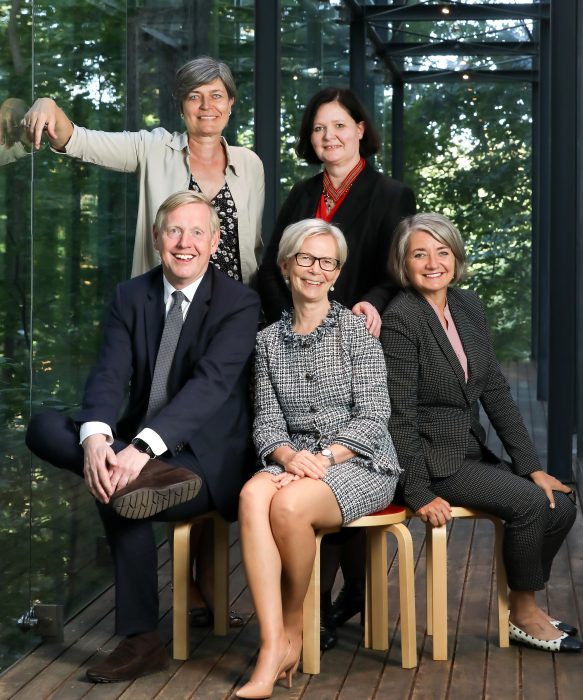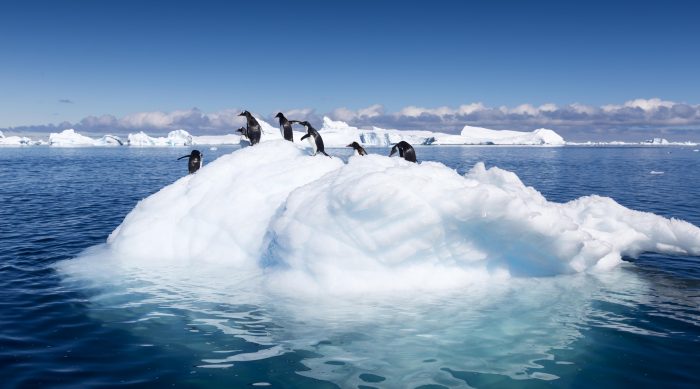By Roland Flamini
The Nordic countries are global front runners in the green transition. Supported by an environmentally concerned public, each of these climate-smart countries has taken major legislative and practical steps towards meeting its Paris Climate Accord commitments, starting with the race towards complete independence of fossil fuels by 2050. We asked the ambassadors of Denmark, Finland, Iceland, Norway and Sweden, for a brief rundown of their respective climate goals and these are their replies, redacted for space and content.

The Nordic Ambassadors pictured at the Embassy of Finland. From top left: Lone Dencker Wisborg (Denmark), Bergdís Ellertsdóttir (Iceland), Karin Olofsdotter (Sweden), Kirsti Kauppi (Finland) and Kåre R. Aas (Norway) Photo © Tony Powell. Nordic Ambassadors Portrait. September 20, 2019
LONE DENCKER WISBORG (Denmark)
Denmark has already cut greenhouse gas emissions by more than 30 percent on 1990 levels, as well as integrating around 50 percent of renewables in the energy system. The next crucial step is to set the path for a society completely independent of fossil fuels by 2050. The government has a very ambitious goal of reducing Denmark’s emissions by 70 percent in 2030 compared to 1990. This requires new instruments and technologies, so the government is also looking at research across sectors in order to pursue a green transition throughout all parts of society.
As an example, the government is initiating reduction targets for the agricultural sector to reduce greenhouse gas emissions. An additional example is the ambition to end the sale of all new diesel and petrol driven cars while instead investing more in public transportation. Another concrete step the government is taking is to initiate a Climate Change Action plan that will ensure that the national reduction targets are actually met. The aspiration for the Danish government is to be among the countries that do the most in terms of combating climate change and to become a “green super power” that can actively contribute to moving things in the right direction globally. The government wants to lead the way in showing the rest of the world how to attract private investments to the green energy sector.
BERGDÍS ELLERTSDÓTTIR (Iceland)
Climate change has already made itself felt in Iceland in the receding glaciers, which now cover 11 percent of the country and may all have melted away in the next 100 to 200 years, dramatically changing the landscape. For an island in the middle of the North Atlantic, the sea is paramount, and for a nation heavily dependent on fisheries the ocean acidification is of grave concern.
Long before the Paris Accord, Iceland started harnessing renewable energy, both hydro and geothermal, to produce electricity and heat houses, so that today almost all electricity, hot water and heating comes from renewable sources. But never before has the government allocated funding to environmental issues as the level now reached. There is also broad political support for a new government climate change action plan, the main emphasis of which are two measures: (1) to phase out fossil fuels in transport, and (2) increase carbon sequestration in land use by restoration of woodlands and wetlands, revegetation and afforestation. Climate mitigation measures will get a substantial increase in funding—almost 7 billion Icelandic krónur ($56.5 million) in the period 2019-2023. A general carbon tax, already in place, will be gradually increased. The aim is that Iceland will be carbon neutral by 2040 at the latest. Iceland will ban new registrations of fossil fuel cars after 2030. Efforts in land use are expected to greatly increase the uptake of carbon from the atmosphere, which is essential for its aim to achieve carbon neutrality by 2040. Often overlooked in this debate is the importance of combating soil erosion and revegetating denuded lands.
KÅRE R. AAS (Norway)
Norway will be climate neutral by 2030, and the government has committed to becoming a low emissions society by 2050. To achieve these goals the Norwegian government has put a range of policies in place: Emissions from the transport sector will be reduced by 50 percent by 2030. In 2025, all new cars sold will have zero emissions or run on biofuel. Strong government incentives are in place to promote the sale and use of electric cars. Today, almost half of the new cars sold in Norway are electric. Car ownership and use are heavily taxed in Norway. Last June, the government launched a new strategy for green shipping. The ambition is to reduce emissions from domestic shipping and fisheries by 50 percent by 2030. The government aims to encourage the use of zero- and low emissions technologies in all kinds of vessels and is expanding the electrification of the transport sector. By 2021, one in three ferries in Norway will be electric. In a European context, since 2008, Norwegian companies have been part of an emissions trading system that puts an overall limit, or cap, on emissions from industry and oil and gas production. Internationally, Norway’s International Climate and Forest Initiative, which pays for reductions in emissions from deforestation and forest degradation in developing countries, is definitely worth a mention. Stopping deforestation is perhaps the single most important measure for the climate. As much as one-third of the emissions reductions needed to solve the global climate problem could be achieved through cuts in emissions from deforestation and forest degradation. Norway contributes as much as half a billion dollars to developing countries via this initiative every year.
KARIN OLOFSDOTTER (Sweden)
Sweden is the world’s largest per capita donor to the climate funds, and will continue its strong leadership for climate action by contributing with policy, financing and innovative technology to support the transition to climate-smart societies and the implementation of the Paris Agreement. Science gives us about ten years to halve the world’s emissions, so accelerated action to reach the goals of the Paris Agreement will be crucial. Sweden will also be the world’s first fossil free welfare nation. Many Swedish enterprises and municipalities have understood that climate change adaptation creates new business opportunities, technologies and better social solutions. Food retail, mining and minerals, and cement are examples of industries that have produced roadmaps to become fossil-free. A very exciting, and globally unique, development of carbon dioxide free steel production is now under way in the city of Luleå, in northern Sweden. The Swedish Government initiated a new initiative ahead of Paris—Fossil Free Sweden— to show how enterprises, cities, municipalities and organizations contribute to climate efforts. As part of this, industries will develop sectorial roadmaps to how they will be fossil free while also increasing their competitiveness. Swedish public climate finance amounted to SEK 6.2 billion in 2018, of which SEK 4.3 billion was channeled through Sida (Swedish International Development Agency). The government has also initiated a robust green tax shift that will increase over the years ahead and introduced a Swedish state green bond.
KIRSTI KAUPPI (Finland)
Finland is currently holding the rotating Presidency of the Council of the European Union, and climate change is the number one priority for its six-month turn at the helm. EU’s medium-term target is to reach 40 percent emissions reduction by 2030 compared to 1990 levels. Key tools in this are a revised Emissions Trading System, new rules on land use and forestry, an EU –wide energy union and updating legislation on renewable energy and energy efficiency. The Paris Agreement requests signatory countries to prepare, by 2020, long-term strategies for climate neutrality. The European Union is working very hard to set a shared vision for our long-term climate goal, climate neutrality by 2050. Finland is doing well on delivering for climate. Most of its companies can be found in the clean-tech sector. That is where innovation is booming. Finland’s greenhouse gas emissions have been cut by 21 percent to 1990 levels and increased its share of renewable energy sources to approximately 40 percent of energy end-consumption. Finland adopted a Climate Act in 2015, among the first countries in the world to do so. Finland’s northern location means that it feel the effects of global warming even more acutely. We have worked and will continue to work hard to make sure that the fragile ecosystem of the Arctic Region is safeguarded. Finland aims to be carbon neutral by 2035 and carbon negative soon after that. This will be done by accelerating emission reductions and strengthening our carbon sinks.
Finland has already decided to phase out coal in energy production by 2029 and is now committed to phasing out fossil oil in heating by 2030.
Read More:
Greta Thunberg Wants Us to Panic, then Act
The Quest for 1.5 Degrees Centigrade




